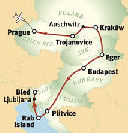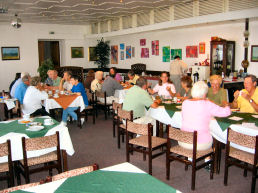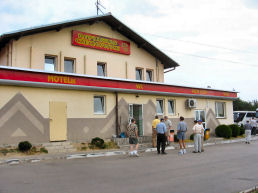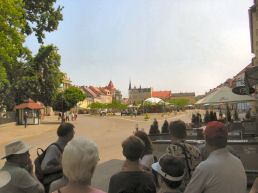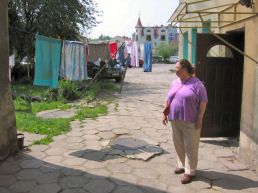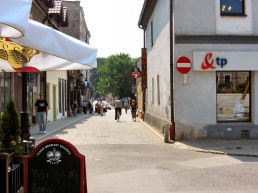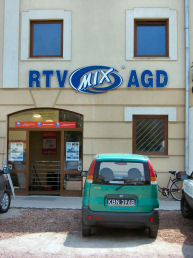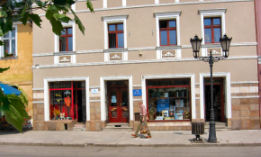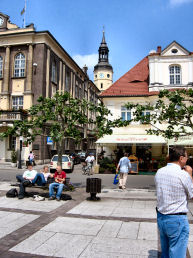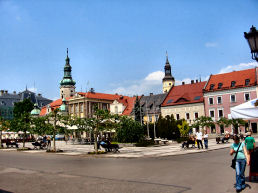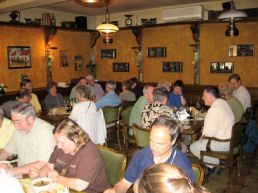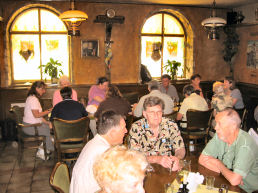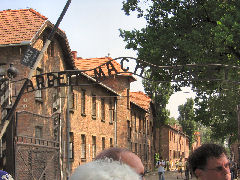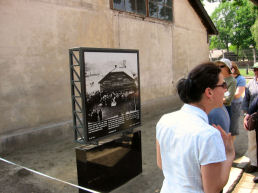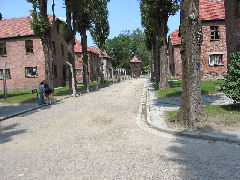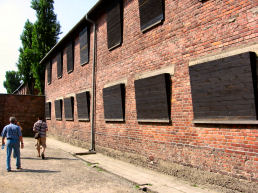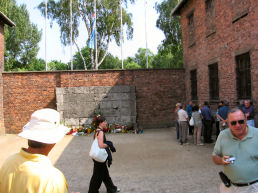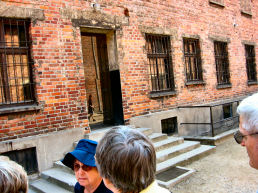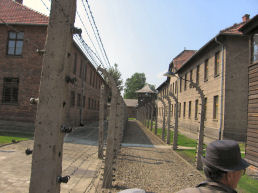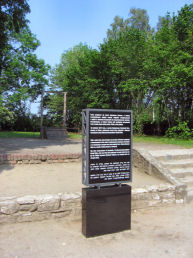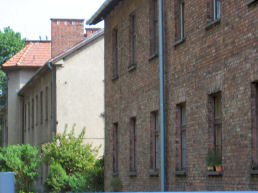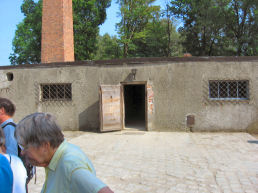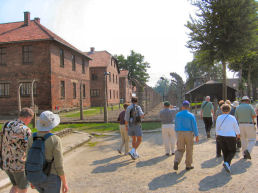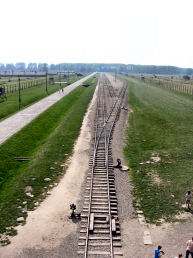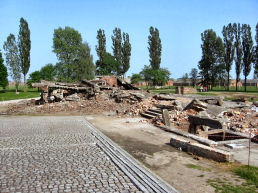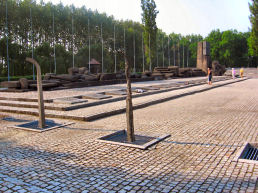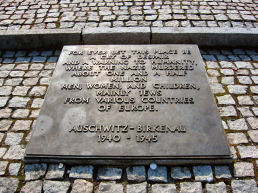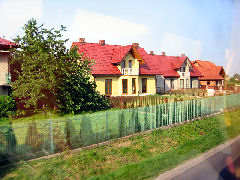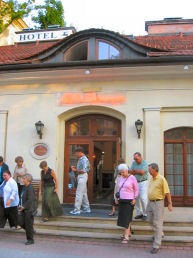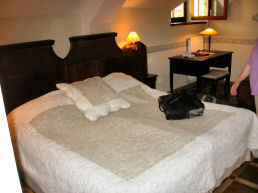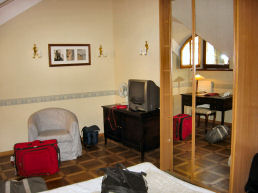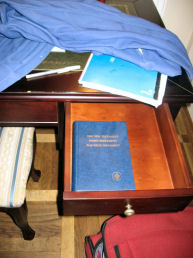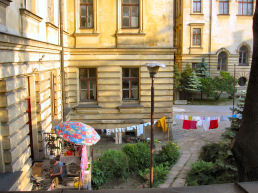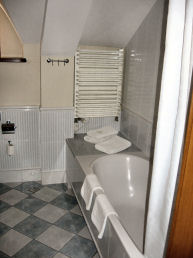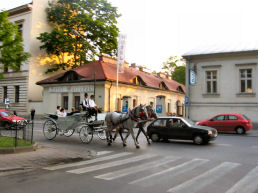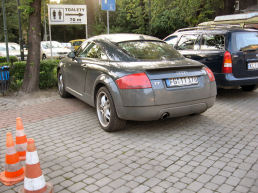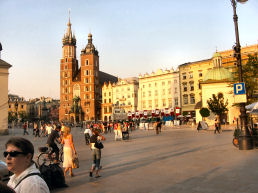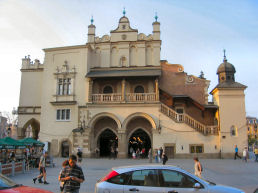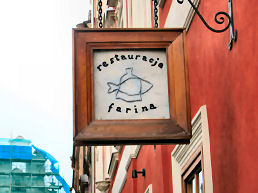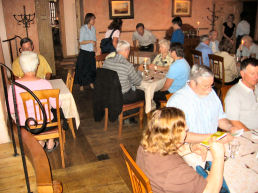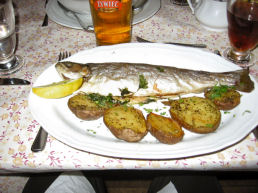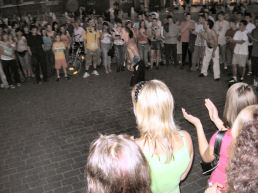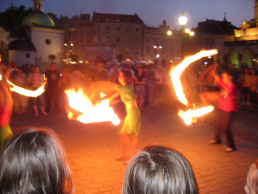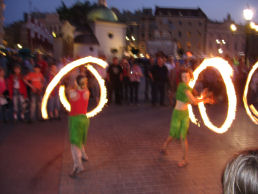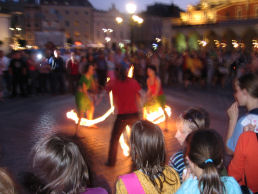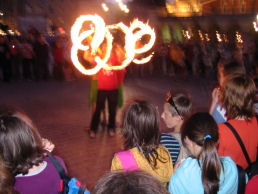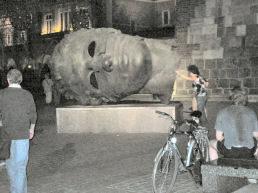I dozed for a few minutes before the 7 a.m. breakfast. That was a major mistake. When I woke up, I could hardly function at all.
The breakfast layout was pretty good, but not as impressive as the one in Prague. As usual, I made a pig of myself. The fried eggs were barely edible, but the link sausages were tasty. I was surprised that they expected us to serve them with a spatula. I never understood eating peas with a knife either.Sue and I sat with Patti and Tom. Nedra sat in the chair next to mine. Sue said that Tom enjoyed doing the polka with one of the girls in the dance troop. The guy with whom Sue danced spoke English. He told her that the group had been to Austin, TX, to perform. It was 97º there in October. He could not get over how hot it was. Sue reported that he also carried a flask of home-made brandy in his back pocket.
Sue brought her gear out to the bus and left me the responsibility of checking the room. After the bus had been on the open road for a few minutes I discovered that my notebook was not in my backpack. I had either packed it in my red suitcase or left it in the hotel room. I could not remember putting it in the suitcase, and I could imagine no reason why I would have done so. So, I had to assume that the notebook was history. The one positive aspect was that my Herculean work that morning had left me only one day behind in the journal, so I had not lost that many notes. The main thing missing was my notes on the introduction of the buddies. I was pretty sure that I could remember most of that.
More than anything I was upset at myself for being so irresponsible. I had now left something behind at two out of two hotels. I resolved to look for a suitable replacement if there was time at our lunch stop.
Bojan headed the bus toward nearby Poland. The border crossing was rather routine. A man in uniform silently collected our passports. They were returned to us a few minutes later.
We stopped for a bathroom break not far into Poland. Susana paid for entrance to the toilets, but I did not need to use the facility. I just walked around outside for a few minutes.I learned at the break that Lyle has been having a problem with one of the toes on his left foot. Since he had cut a hole in his shoe, he reported that it does not bother him as much. I suppose that his solution was less drastic than amputating the toe. It would take a lot for me to take a knife to a pair of shoes. I tend to think of each pair as a ten-year investment.
I asked Anne Miller for more details concerning the exhibit of popes about which she and Paul told me. She said that it was located at or near Catholic University in Washington, D.C. Evidently there is some kind of facility there dedicated to Pope John Paul II. A timeline of popes with portraits and short biographies is evidently quite extensive. I made a mental note to try to see it if I am in the area.
I thought of telling them a few stories about the debaters that I knew from CUA, but I decided that it might not be politic to do so. Ringer and Mooney would never have been mistaken for Dominic Savio.
Susana told us that a concert of Mahler's 6th Symphony would be held somewhere in Kraków. I quickly decided to pass on it. Mahler's music has always been beyond me.
Susana related a good number of interesting facts about Polish history. In the thirteenth century the Poles were at war with the Prussians, another Slavic (!) tribe. They asked the Germans for help. Some German knights came and helped the Poles defeat the Prussians. Could this be in Frederick II's time? If memory served, he was Holy Roman Emperor during most of the first half of the thirteenth century. The Poles built up Gdansk (Danzig in German) as a seaport. The heyday of the Polish kingdom was in 1410 when they defeated the Germans at Grunwald. Poland had a parliament (Sejm) and a king who served only as head of state. They decided that all parliamentary decisions had to be unanimous. This was disastrous; nothing got done. King Jan III Sobiesky defeated the Turks at Vienna in 1683. I seemed to remember that Eugene of Savoy played a prominent role as well. In the eighteenth century Poland was split among Germany, Austria, and Russia. After World War I, Poland became an independent country, but with different borders. Six million Poles died in World War II.
Poland is currently governed by a center-right coalition headed by twin brothers named Kaczyński. Lech was elected president; Jaroslaw was appointed prime minister by the Polish parliament. As children they had starred in Polish cinema. Susana said that the overall unemployment rate in Poland is an astounding 40 percent. Even among the young educated people it is 38 percent. Now that Poland is a member of the European Union many young Poles take jobs abroad as waiters and the like. Recently scandals concerning collaboration between Polish priests and the Communists have come to light. Lunch was in Pszczyna, a small town not too far from the Czech border. At one time the town was part of the Silesia area of Germany, but in 1920 the people voted to become part of Poland. Susana pointed out the "castle" as the bus neared the town. The orientation walk basically just let us know where the bankomats, the exchange office (kantor in Polish), and the restaurant were located. I went to an ATM and got 600 złoty. I gave half of it to Sue. Next time I would try to remember to ask for a less round number. The lowest denomination that the machine delivered was 100 złoty notes, which were worth about $35.Sue and I wandered around the very nice little town for a few minutes. Sue wanted to buy a disposable camera. I have never been understand why she refused to buy herself a digital camera before we left. Her digital camcorder has not been reliable for several years. Disposable cameras seemed to me to be a huge waste of money in this day and age. After we walked down a few streets, I took photos of some people's laundry. Chick has always loved these photos. Shortly thereafter we passed an electronics store. Sue thought that it might be a good place to find a disposable camera, and she was proven right.
She came out of the store accompanied by a young blonde woman named Ewa Tkaczuk. A common name in our home town of Enfield is Tkacz (which the family pronounces TEE kazz). I took photos of Sue and Ewa. In the second one I was careful to get her name tag. [These photos, along with quite a few others that I took in Pszczyna, are mysteriously missing. They are not on my disk, and there are no sequence numbers missing.] Ewa spoke English quite well. She could not believe that people from the United States had wandered into the store in which she worked. Sue had asked her where we might buy a spiral notebook. It took her a little while to understand what Sue was talking about. Eva then tried to explain where the store was that might sell one. This was a challenge for her in English. She decided to escort us down to the town's main square and point it out. We could not believe that she would leave her job to do this for us. We went into the shop that Ewa indicated. It was named Lokay, which Ewa pronounced with an l sound, not a w sound. Sure enough, they offered for sale quite a few A4 notebooks. The pages were lined like graph paper, but they would do fine for note-taking. It only cost me 4.95 złoty to purchase one. I tried to use one of my 100 złoty notes, but the clerk did not want to give up so much change. Sue found a five złoty coin. We should have told her to keep the change, but she gave us back tiny coins called grosz. These things are only worth about .3 cents each. I had to think that it surely must cost more than that to mint them. Sue and I decided to split up until lunch. I took quite a few photographs of the town's picturesque square. I also made sure that I had pictures of both stores for the journal. I encountered Lee and Joanne strolling through the park. They asked me to take another picture of them with a different camera. They seem to have cornered the market on cameras that provide absolutely no feedback when they take a photo.The group assembled for lunch at a restaurant with the peculiar name of Va Banque. We went down into a very nice seating area. I was seated between Lee and Sue across from Patti. They served us very small glasses of water and black currant juice (identified by Lauren). They evidently were not used to the consuming habits of thirsty Americans. The meal began with a delicious salad of tomato, cheese, olives, diced cucumbers, and either lettuce or cabbage. This was followed by a soup based on sourdough bread. Dessert was strawberries with yogurt or cream on top.
The only part of the lunch that I did not enjoy was the bit that stained my pants. The napkins at this establishment were only about six inches on the side. They were not suitable for protecting one's clothes from sloppy eating habits. I mean, these were Americans that they were entertaining, not dainty Belgians or fastidious Swedes. I should have bought a stapler at Lokay. I could have manufacturing adult-sized napkins out of four of the ones they provided and then earned a lot of złoty marketing my creation to tour members. Besides, it would have done the Poles good to seem some Yankee ingenuity in action.Every restaurant in which we had dined had delivered plates, napkins, and cutlery the same way. The plates were stacked. Piled on them were the napkins. On the very top the knives, forks, and spoons were arranged in an artistic manner.Lyle discovered on the bus that he had left his bag in the restaurant. However, someone had brought it to the bus for him. His forgetfulness made me feel a little better. Perhaps I was not the only bonehead on the tour.
On the bus ride to Auschwitz Susana informed us that the Communists did not dare to attempt to collectivize the farms in Poland. As a result, Poland still was left with a large number of small farms that have proven too small to compete in the global economy. Poles evidently have not been too successful at industrializing either. I assumed that our government reimbursed them well for their pivotal role in our "extraordinary rendition" policy.
We learned that two Auschwitz camps were open to the public. Auschwitz I could be found in the Polish town of Óswięcin. It was originally built to hold Polish political prisoners. Only after 1942 did it become part of the notorious "final solution."Our guide at Auschwitz, whose name was the Polish version of Agnes (I had to ask Susana; her name tag was not readable), looked a lot like a younger version of my sister. She was quite soft-spoken. I tried to get as close to her as I could whenever she stopped to explain an exhibit. Even so, I probably missed a fair amount. She solemnly provided a lot of facts and statistics about the whole ugly scene:
- Three million out of the eleven million European Jews had lived in Poland.
- An estimated 1.5 million people were killed at Auschwitz. 90 percent of them were Jews. The next largest group was Poles. The camp also held Russians and gypsies.
- The people came by train from all over Nazi-occupied Europe. They were shipped in cattle cars of eighty to one hundred people. They had to buy their own train tickets! This policy helped to fund the project and ironically helped to convince many of the Jews that they were being relocated to start a better life. Many, in actual fact, died en route because of the horrendous conditions.
- Most were separated from their families. The Nazis also maintained some family camps so that they would have something to show to the Red Cross.
- Auschwitz II (Birkenbau) was fifty times as large as Auschwitz I. Up to 100,000 people were detained there at a time. The third camp was called Monowitz.
- Eight hundred people attempted to escape, but only 145 succeeded. For each person who escaped, ten people were hung during roll call.
- Fr. Maksymilian Kolbe volunteered to substitute himself for one of those who were scheduled to die. Agnes said that the man whose life was saved by that heroic act was still alive.
Inside the exhibit no photos were allowed. We viewed the personal effects of some of the victims - twenty thousand pairs of shoes (including at least one boot that must have been at least a size 18), eyeglasses, suitcases with people's names on them, and two tons of human hair. The last was used to weave mats that would ordinarily have been made from horse hair. Everything of value was taken from the detainees, stored in two warehouses named Canada I and Canada II, and eventually recycled in Germany. Evidently the exhibit represented only a tiny fraction of the total quantity of confiscated goods.
On display were many canisters of Cyclone B, the gas that was used to kill so many people. The most stunning of the many touching photos depicted the camp doctor designating with his thumb pointing right or left whether individuals just off the train were fit for work or were subject to immediate execution. The Nazis could kill people a lot faster than they could dispose of their bodies. Very hot furnaces burned night and day to keep up with the executions.
Survivors of the camps weighed as little as fifty pounds when they were rescued.
In Birkenau we saw the barracks that housed so many people. Between eight and nine hundred resided in each building! Some wooden ones had been used as stables in Germany. They held only fifty-two horses. The detainees at Birkenau were subject to starvation diarrhea, huge rats, typhus, and who knows what else.
Especially chilling was barracks #11, which had held political prisoners. They were forced to work, and then they were jammed into incredibly small places. The stand-up cells were only a little larger than phone booths, and they held four people. The people had to get down on all fours in order to crawl into these "cells." The first use of Cyclone B was to kill prisoners in building #11.
Between building #10 and building #11 stood the wall of death against which prisoners were lined up to be shot in the head. The occupants of building #10 were not allowed to see or hear this. The executions were clearly visible to the occupants of building #11 were. They already knew their inevitable fate. Some female prisoners, who lived on the other side of the railroad tracks, blew up gas chamber #4 on October 7, 1944, by smuggling in explosives a little at a time. The others were destroyed by the Nazis in order to eliminate the evidence. Many of the Nazis escaped, but the commander, Rudolf Höss, was hung. The gallows is still there.
Tom walked out to the monument some distance behind me. Evidently he saw me, but I never saw him. I saw others, but it did not seem right to interrupt anyone's thoughts.
After a little break for juice or water we departed for Kraków. The most amazing thing to me about the whole experience was the fact that someone was running a large hot dog stand at Birkenau. Who in the world would eat at such a place? The suburbs of Kraków through which we drove seemed pretty nice considering all of the bad things that we had heard about the economic situation in Poland. Bojan was able to drive the bus right up to the front door of the Maltański Hotel, which was located on the edge of the Planty within easy walking distance of Wawel Castle. Sue and I were assigned room 17. Patti and Tom were across the hall in room 16. The rooms seemed exceptionally nice. It was a little hot, and the ventilation was not too good, so Sue really appreciated the fan in the room.
Susana, who had to stay in a different hotel, had told us that Internet access was formerly free. She told us that they now charged for it, and it was expensive.
When I unpacked, I discovered that back in Trojanovice I had indeed absent-mindedly thrown the notebook that I brought from home into my suitcase. I had therefore not lost my notes after all. I was able to augment what I had written on the bus about the introductions of the buddies. On the other hand, I seemed to have misplaced my scissors. I hoped that they would eventually turn up, but I had my doubts. In tourist areas it is not easy to find places that sell mundane things like scissors. Although Kraków is definitely a real city, the stores in the Old Town area were mostly touristy. Susana led us out through the gigantic Main Market Square, which measures 200 meters on a side, to Restauracja Farina. The first sight of the square was the closest thing to a "wow" moment that we have experienced on this trip. It was truly impressive. There were many carriages pulled by pairs of horses for tourists to ride around in. There were also golf cart tours, rickshaw tours, and virtually any other gimmick that one could possibly imagine. Restaurants featuring open-air dining were positioned on all sides of the square. It was populated day and night by young people and tourists. In the middle was the Cloth Hall, which was now dominated by merchants selling jewelry and knickknacks.
The sign above the restaurant's door had a fish and a bag of some sort. I never discovered what the bag symbolized. [The website said that it was a bag of flour.] We sat with Tom and Patti and Steve and Janet. The staff served us pitchers of a soft drink called kwass and water. I liked the kwass, but no one else at the table did. Steve and Janet ordered red wine, which was called Montepulciano, but they indicated that it was not very good. Tom and Sue and I had Żywiec beer. We did not consider it as good as the Czech beer had been. The first course was borscht, a beet soup that contained an egg. I ate my whole bowl, but it was a long way from the best soup that I ever tasted. They served us salad and vegetables family style, but there was no room on the plate for both salad and vegetables. The main course was trout or pickled pork. The trout came with skin, bones, head, and tail. It had at least been filleted. I enjoyed the trout, although it was a little difficult to eat. The people who had the pork seemed less enthusiastic about the experience than the trout eaters. For dessert we had a strawberry flavored cake with whipped cream. It was very good. For some reason they gave us tiny forks with which to eat it. We had a good time conversing with the Sharps. We learned that Janet gave Steve dancing lessons as a gift on Valentine's Day. What a thoughtful present! We also learned that she once gave him a bread machine for his birthday. Steve's brother has recently taken up ballroom dancing, and Steve is worried that he might lose his scuba diving companion. Janet also insisted that Steve had maneuvered the seating at the Moravian folk dancing so that the cutest girl was virtually forced to ask him to dance. On the return walk to the square we saw some break dancers with amazing moves. I tried to photograph them; one or two came out OK, but I had the wrong setting on the camera for six or eight of the photos. The break dancing was abruptly interrupted by a horse-drawn carriage plowing through the crowd. I thought that I detected a smirk on the driver's face. We then saw an impressive demonstration in which three girls and a guy twirled flaming batons to the beat of four or five drummers. I managed to get a few decent pictures using the night setting on the camera.
A trumpeter announced each hour from the municipal watchtower next to St. Mary's church in one corner of the squares. He played a short tune with an abrupt ending called the hejnał in each direction. Try as I might I was not able to see him. I vowed to try to get a decent photo of the performance before we left Kraków.
Sue and I walked back to the hotel. I really should have somehow signed on to the Internet to retrieve my e-mail from the office, but I had no energy whatever. I just went to bed.
